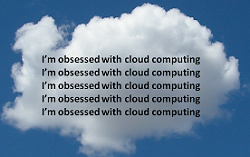Blind to Folly
Silicon Valley has OCD: obsessive cloud disorder.
No jargon occupies the Silicon Valley lexicon more than cloud computing — except social media and mobile. Cloud has become an absolute obsession, and a ridiculous one at that.
 The danger with obsession: The more one is obsessed with something — especially a product, technology, or industry — the more blind he is to its folly. Sound familiar?
The danger with obsession: The more one is obsessed with something — especially a product, technology, or industry — the more blind he is to its folly. Sound familiar?
I’ve written several articles about the folly of cloud computing, but the OCD crowd ignores dissension. A few weeks ago, I attended a tech conference in Silicon Valley, where “cloud” dominated the agenda and the narrative. Not one speaker on the roster debated cloud’s detriments and drawbacks. Not one detractor.
The aforementioned conference was more like a religious revival than a logical business forum. We heard about public clouds, private clouds, and hybrid clouds. Huh? The lemmings in attendance left the event convinced that weaving cloud into their discussions and brands is a good idea. Nonsense.
What are the detriments and drawbacks of cloud computing?
- Confusion: Nobody, outside the Silicon Valley bubble, understands this nebulous jargon. Ask a retailer in Ohio. Why cause customer confusion with vendor-speak?
- Contradiction: The word itself is the antithesis of stability and clarity. Anyone who’s flown through a cloud knows that, unlike a steel vault, it is comprised of water vapor — intangible, ephemeral, amorphous, borderless. In social discourse, cloud always has a negative connotation (e.g., clouded judgment).
- Common: The objective of branding is to convey unique, compelling, and memorable value. If every vendor uses the same generic, meaningless term — cloud — blending is the rule; building a unique brand is impossible.
- Unsafe/Unwise: Never put all your eggs in one basket — cloud computing does exactly that. Many sites have been hacked, millions of passwords stolen. Yet, the OCD crowd ignores the safety, reliability, and control of on-premises computing.
Infrastructure Is Invisible
Since Larry Ellison, Oracle’s CEO, converted from cloud scoffer to embracer, no Silicon Valley luminary has publicly lambasted cloud computing — until now: Steve Wozniak, cofounder of Apple, recently called it horrendous and averred: “The more we transfer everything onto the web, onto the cloud, the less we’re going to have control over it.” Bingo, Woz.
When articulating a value proposition — a brand — one must employ customer (not vendor) language. Technology is a means to an end, not the end. A brand must be about value and benefits, not infrastructure. When buying a TV, does the customer get a lecture on the PG&E grid? Of course not. Infrastructure is invisible; he just wants to enjoy the Super Bowl.
Jack Dorsey, CEO of Square and chairman of Twitter, opined to Fortune in July 2012: “To me, that is the pinnacle of technology — when the technology disappears completely.” Exactly, Jack. But, tell that to the OCD crowd.
Rx from the WhiteNoise Doctor™
The first irony here is that psychological OCD, manifested by excessive hand-washing or pencil-aligning, is about gaining control: One who’s lost control of something major in his life compensates by trying to control something small.
With Silicon Valley OCD, one loses control. On one hand, the buyer of cloud-based products and services loses direct control of his computing resources. Weather storms, hackers, and malfunctions can impair or destroy everything he owns. Plan B? Oops, there is no Plan B.
On the other hand, the vendor using “cloud” in its name, in its messaging, in its orientation, loses brand control and, therefore, its customers, investors, and media following. How? By blending into the white noise of me-too competition.
The second irony: Silicon Valley is very sunny, with nary a cloud in sight during the summer months. The only way Silicon Valley can cure its OCD is by letting that sunshine in.
POSTSCRIPT #1: Amazon Cloud Service Goes Down, Takes Popular Sites With It
POSTSCRIPT #2: Amazon Cloud Service Failure Takes Netflix Down on Xmas Eve
POSTSCRIPT #3: Federal Reserve System Hacked
POSTSCRIPT #4: Facebook Was Hacked
POSTSCRIPT #5: Apple Was Hacked
POSTSCRIPT #6: Chinese Army Hacked 115 US Companies
POSTSCRIPT #7: Microsoft Hacked; Azure Cloud Service Inaccessible
POSTSCRIPT #8: Twitter Hacking Puts Focus on Security for Brands
POSTSCRIPT #9: Chinese Hackers Steal US Weapons Secrets
POSTSCRIPT #10: US Government Secretly Mines Your Private Internet Data
POSTSCRIPT #11: Hacked Apple Developer Site Wreaks Havoc
POSTSCRIPT #12: NSA Collects 75% of All Internet Traffic
POSTSCRIPT #13: NSA Scandal Hurting Cloud Revenue
POSTSCRIPT #14: Nirvanix Demise Signals Storms for Cloud Computing
© 2012 Marc H. Rudov. All Rights Reserved.
About the Author

Marc Rudov is a branding advisor to CEOs,
producer of MarcRudovTV, and author of four books

